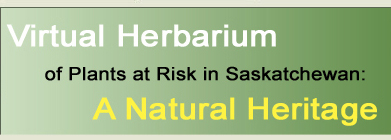|
| Elymus diversiglumis
Scribn. & Ball |
|
| |
| TAXONOMY |
| |
| Family: |
Poaceae |
| Genus: |
Elymus |
| |
| Species Synonyms: |
Elymus interruptus auct. non Buckl. |
| Common Names: |
diverseglume wildrye
Texas wildrye
variable-glumed wildrye
interrupted wildrye |
| |
| DISTRIBUTION |
| |
| Canada: |
Saskatchewan – Manitoba – western
Ontario |
| Saskatchewan: |
eastern and central Saskatchewan; Prince Albert
– Saskatoon – Souris River Valley |
| Ecoregion: |
Moist Mixed Grassland, Aspen Parkland, Boreal
Transition, Mid-Boreal Lowland |
| |
| HABITAT |
| |
| Saskatchewan: |
moist rich deciduous woods and thickets |
| Canada: |
thickets and woods |
| |
| RARITY STATUS |
| |
Provincial
Status According
to Harms (2003): |
Threatened |
| Nature Conservancy
Status: |
G5 S2 |
Saskatchewan
Species at
Risk Status: |
None |
| COSEWIC Status:
|
None |
| |
| Diverseglume wildrye
is threatened because it is rare or uncommon in Saskatchewan. Possible threats,
including habitat loss, have been identified for this species. |
| |
| SPECIES
DESCRIPTION |
| |
| Height: |
80 – 150 cm |
| Roots: |
fibrous; rhizomes lacking |
| Stems: |
tufted, hollow, green or bluish |
| Leaves: |
8 – 40 cm long, 8 –
13 mm wide, flat, long-hairy on nerves of upper surface, hairless below;
sheaths hairless; ligules 1 – 2.5 mm long, membranous; ear-like lobes
at base of leaf inconspicuous to 2 mm long |
| Inflorescence: |
spikes arching at maturity,
8 – 24 cm long, loose |
| Spikelets: |
1 – 3 per node of central
axis, closely appressed, containing 2 – 4 florets |
| Florets: |
glumes bristle-like or absent,
unequal, 2 – 6 mm long, less than 0.5 mm wide, base rounded and hardened;
lemma 8 – 12 mm long (excluding awn), hairy; lemma awn 2 – 3
cm long, divergent at maturity; palea 8 – 9 mm long, shorter than
lemma |
| Fruits: |
grain |
| |
| ELYMUS
KEY FOR SPECIES FOUND IN SASKATCHEWAN |
| |
| 1 Spikelets 2 or 3 at each node or
central axis, 1 – 6-flowered; lemmas obscurely 5-nerved |
2 |
| 1 Spikelets solitary at each node
of central axis, each spikelet with at least 2 florets; lemmas 5 –
7-nerved |
8 |
| |
|
2 Glumes, if present, bristle-like,
divided to base into 2 divergent awns; central axis of spike readily separating;
plants mostly 10 – 50 cm tall
|
E. elymoides ssp. elymoides |
| 2 Glumes bristle-like or not; central
axis of spike not readily separating; plants mostly taller than 50 cm |
3 |
| |
|
| 3 Glume margins membranous, not nerved;
lemmas hairless to rough hairy |
E. glaucus ssp. glaucus |
| 3 Glume margins thickened, hard, and
nerved; lemmas densely hairy |
4 |
| |
|
| 4 Glumes bristle-like, reduced or
absent, usually < 6 mm long (excluding awn) and 0.5 mm wide |
E. diversiglumis |
| 4 Glumes linear, usually at least
1 cm long (excluding awn) and 1 – 2 mm wide |
5 |
| |
|
| 5 Glumes shorter than lemma body;
lemma awns divergent at maturity; base of glume flattened |
6 |
| 5 Glumes equal to or longer than lemma
body; lemma awns straight at maturity; base of glume rounded or bowed |
7 |
| |
|
| 6 Leaves firm, hairless or rough hairy
above; spikes arching; palea to 1.1 cm long |
E. canadensis var. canadensis |
| 6 Leaves thin, long hairy above; spike
pendulous; palea to 1.5 cm long |
E. canadensis var. wiegandii |
| |
|
| 7 Glumes and lemmas long-awned (to
1.5 cm) |
E. virginicus var. virginicus |
| 7 Glumes and lemmas sharp-tipped to
short-awned (< 2 mm) |
E. virginicus var. submuticus |
| |
|
| 8 Rhizomes short or absent; florets
separating above the glumes; anthers 1.5 – 2 mm long |
9 |
| 8 Rhizomes long and creeping; florets
separating below the glumes; anthers 3 – 7 mm long |
10 |
| |
|
| 9 Awns equal to or longer than lemma |
E. trachycaulus ssp. subsecundus |
| 9 Awns absent or much shorter than
lemma |
E. trachycaulus ssp. trachycaulus |
| |
|
| 10 Leaves flat, 4 – 8 mm wide,
green; lemmas hairless or nearly so |
E. repens |
| 10 Leaves rolled, 1 – 3 mm wide,
bluish; lemmas usually hairy |
11 |
| |
|
| 11 Glumes 2 – 3-nerved; lemmas
long-awned |
E. albicans |
| 11 Glumes 3 – 5-nerved; lemmas
awnless |
12 |
| |
|
| 12 Spikes to 25 cm long, central axis
hairy below spikelets; glumes conspicuously 5-nerved; lemmas densely hairy |
E. lanceolatus ssp. psammophilus |
| 12 Spikes to 15 cm long, central axis
hairless below spikelets; glumes 3-nerved, only the midvein conspicuous;
lemmas hairless or hairy |
13 |
| |
|
| 13 Lemmas hairless or rough-hairy |
E. lanceolatus ssp. lanceolatus
var. riparium |
| 13 Lemmas long-hairy |
E. lanceolatus ssp. lanceolatus
var. lanceolatus |
| |
|
| *Elymus hybrids
occur naturally in Saskatchewan. E. X maltei (E. canadensis
x E. virginicus) and E. X pseudorepens (E.
trachycaulus x E. lanceolatus) are examples. |
|
|






